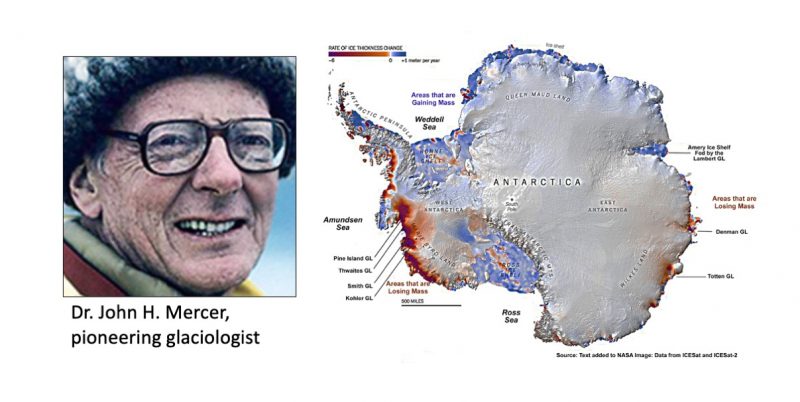Mercer’s Famous Sea Level Forecast – 42 Years Later

It was 42 years ago when the late glaciologist Dr. John Mercer made an ominous fifty year forecast about melting in Antarctica causing catastrophic sea-level rise. Because he was one of the first scientists to warn that a certain cascade of events could result in as much as 16 foot higher sea level, it’s more than interesting to revisit what he wrote. Back then global warming or climate change was hardly a major issue of concern, even in the scientific community.
On the level of carbon dioxide, the main greenhouse gas, he was a bit early. He wrote that CO2 could have doubled from the pre-industrial level, which would bring it to about 560 ppm (parts per million). Today it’s at 415 ppm, and might reach somewhere around 440 ppm at Mercer’s fifty year benchmark in 2028, so that part of his forecast is not too impressive.
But the important part of Mercer’s warning, was that increasing CO2 levels, would cause polar warming, starting a melting of the unstable West Antarctic Ice Sheet. The base of several mega-glaciers in that section of Antarctica are special because their base is far below sea level. He foresaw that these “marine glaciers” would be the most prone to rapid melting. Even back then the estimate was that West Antarctica had enough ice to raise global sea level five meters, 16 feet, if it all melted. The last four decades have shown that with that clarity, he was ‘spot on.’ To quote Mercer’s prescient 1978 article in the scientific journal NATURE:
“If present trends in fossil fuel consumption continue, and if the greenhouse warming effect of the resultant increasing atmospheric carbon dioxide is as great as the most advanced current models suggest, a critical level of warmth will have been passed in high southern latitudes 50 years from now, and deglaciation (reduction) of West Antarctica will be imminent or in progress. Deglaciation would probably be rapid once it had started, and when complete would have led to a rise in sea level of about five meters [16 feet] along most coasts.”
The two largest glaciers there are Thwaites and Pine Island. Thwaites has recently been referred to in the press as “The Doomsday Glacier” since it holds enough ice to change global sea level significantly by itself. In the last several years, sophisticated measurements show that both those glaciers are accelerating both in melting and in movement towards the ocean. One of the articles in my news digest recently described the joint British-American five year, fifty million dollar study to get a better understanding of what is happening in that extremely remote location and worth a read for those interested.
Also, a recent featured article in the American Geophysical Union magazine caught my eye: “Glacial Earthquakes First Seen on Thwaites.” It literally gave me chills. That’s a strong validation of Mercer’s warning forty two years ago. Thwaites is the dominant glacier in West Antarctica, the focus of Mercer’s concern. To put Thwaites in scale, it is almost the size of Florida. Gravity will take it into the ocean sooner or later, at which point that single glacier will raise global sea level more than one and a half feet (half a meter). In addition to melting and entering the ocean as water, the glacier is rumbling along at a few miles a year, slowly affecting global sea level. But glaciers are also prone to sudden collapse, somewhat like an earthquake or avalanche. Those abrupt events defy precise prediction, similar to our inability to know when major earthquakes or avalanches will occur.
What happens to the glaciers and ice sheets of Antarctica and Greenland directly determines sea level rise and shorelines all over the world. It is extremely important that we do everything possible to slow the global warming, which mostly means reducing carbon dioxide as a principle greenhouse gas. At the same time, we need to begin preparing for eventual sea level rise, that is now unstoppable. Also we must continue the scientific effort to better understand what is happening in the world of glaciers and ice sheets. Dr. John Mercer was a real pioneer. Today, glaciology is a growing area of scientific study; one might even say it’s hot.
